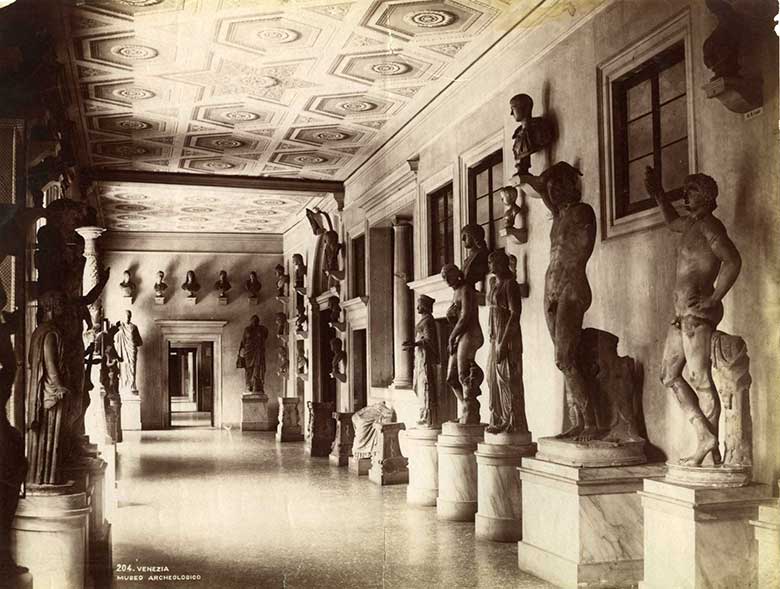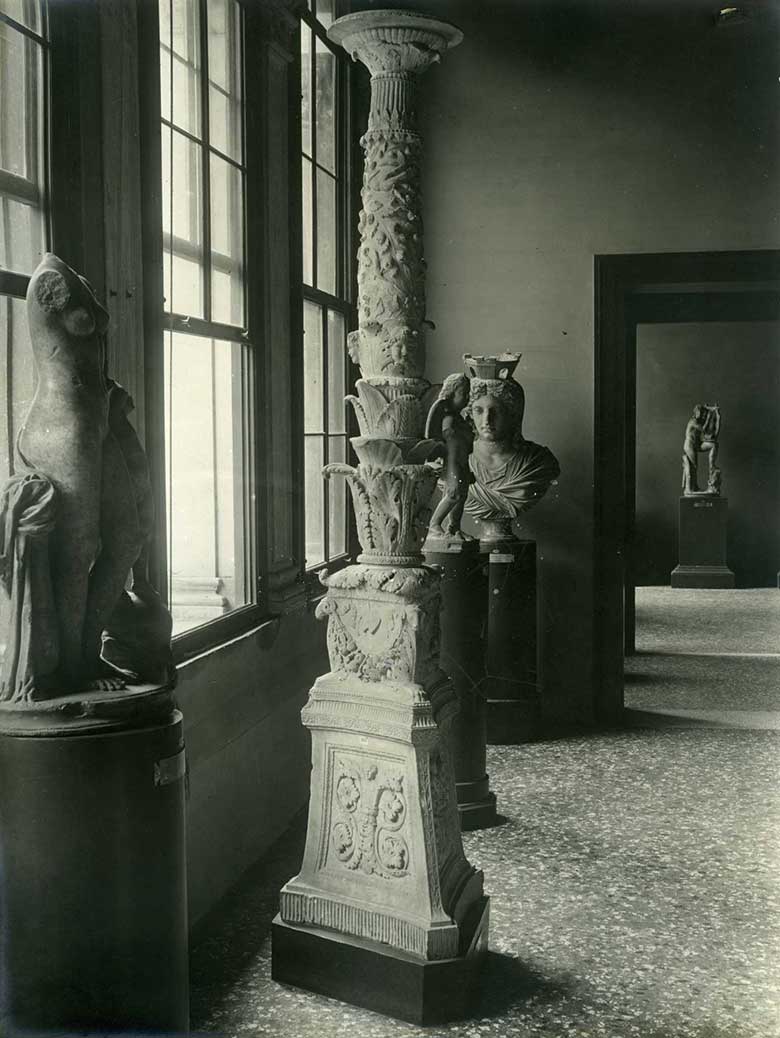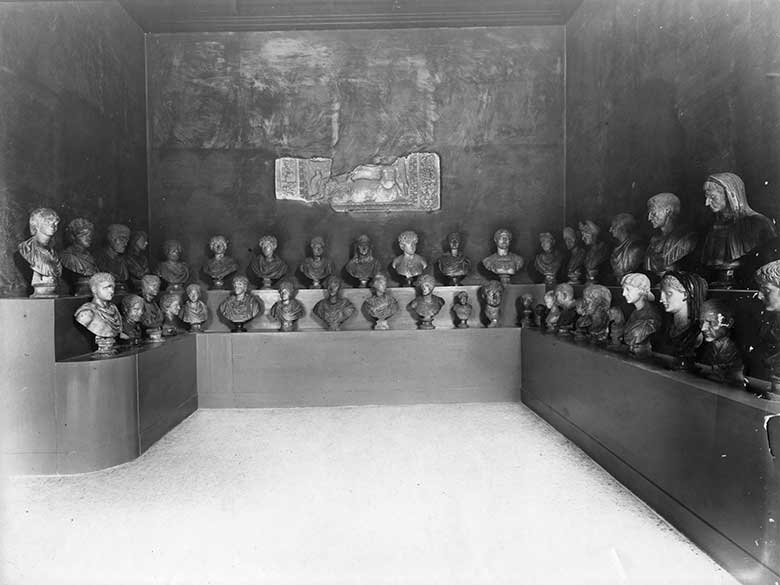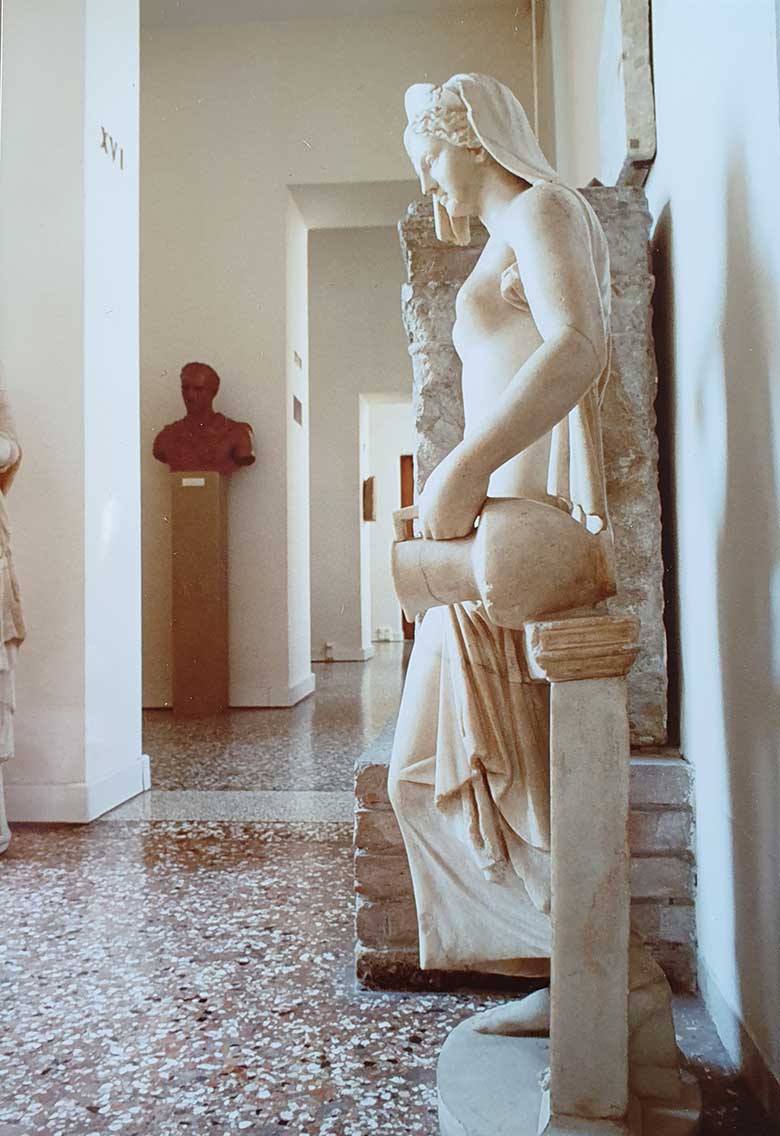National Archaeological Museum of Venice
Our History
On Square since 1596

1523
1523
AN ILLUSTRIOUS PRECEDENT
Domenico Grimani bequeathed his art collection to the Republic of Venice. The Signoria returned most of the sculptures and paintings to the family, retaining only sixteen ancient marbles: eleven busts and five statues. Since 1525, they have been placed in a room of the Doge's Palace called the Sala delle Teste from their presence.
1587
1587
A GENEROUS GIFT
In 1587, Giovanni Grimani, patriarch of Aquileia, donated his famous collection of ancient sculptures to the Serenissima Republic. However, he wanted the statues to remain united and displayed conveniently for their value. Foreigners visiting Venice, «after having seen the Arsenale and the other wonderful things in the city,» would thus be able to admire the public collection of antiques as worthy of note.
1596
1596
THE PUBLIC STATUARY
After years of preparations, the choice of an illustrious location - the Vestibule of the Marciana Library in St. Mark Square - and the architect Vincenzo Scamozzi, the ancient marbles left Palazzo Grimani, recorded in careful inventories and stamped with lead seals with the lion of St. Mark. On 19th August 1596, the procurator Federico Contarini declared in the Senate that the works had ended and the museum was complete.
1616-1625
1616-1625
THE FIRST CENTURY OF LIFE
The first century of life brought some changes to the museum layout. In 1616, some sculptures decorated the niches of the Clock facade in the courtyard of the Doge's Palace, completed in a classical style. A few years later, a Greek statue of Athena also went to the Doge's Palace. Finally, in 1625, the Senate decided to embellish the Hall of Arms of the Council of Ten again with three antique busts from the museum.
1683
1683
A COIN TREAUSURE
In 1683, Senator Pietro Morosini nominated the Republic of St. Mark heir to his collection of coins and medals: 3400 pieces. The Serenissima decided to keep it in the Doge's Palace, in the Armoury of the Council of Ten, and entrusted one of the most eminent experts of the time, the French physician and scholar Charles Patin, to prepare the catalogue. Entitled Treasure of ancient and modern coins, it was one of the first and most significant numismatic books published in Italy.
1736
1736
THE ZANETTI CATALOGUE
Anton Maria Zanetti the Younger was the Keeper of the Marciana Library from 1737 to 1778. He was responsible for the first illustrated catalogue of the museum's sculptures. In three volumes, he ordered the drawings of 224 sculptures with detailed descriptions of the subjects and five overall designs of the walls and the central space of the Vestibule. The catalogue would later be used for administrative purposes and as an illustrated guide to the collection.
1784-1795
1784-1795
AT THE END OF THE REPUBLIC
In 1784 books, coins and medals, gems and cameos, bronzes from the Abbey of San Giovanni di Verdara in Padua passed to the Serenissima following the suppression of the order of the Lateran Regular Canons. In March 1795, with the testamentary bequest of the ambassador Girolamo Zulian, a collection of more than 200 artworks arrived: classic marbles, ancient ceramics, examples of Egyptian art, bronzes, ancient and modern gems. The keeper of the Statuary at that time, Jacopo Morelli, and the sculptor Antonio Canova planned the enlargement of the museum.
1812
1812
THE MOVE
On 29th August 1811, the Viceroy of Italy, Eugene de Beauharnais, decreed the relocation of the library and museum to the ex-Doge's Palace «to next 1st January at the latest». Thus began a new phase in the history of the museum. Following the move, marbles and inscriptions were placed in the largest rooms, the Maggior Consiglio and the Scrutinio. The purely decorative design project was entrusted to the painter and set designer Giuseppe Borsato that, in those years, was responsible for the decoration of the Royal Palace.
1846
1846
IN THE DOGE’S ROOMS
In 1825 Pietro Bettio proposed a project to rearrange the museum's sculptures in the former doge's apartment. Therefore, Bettio himself, the scholar Emanuele Cicogna and the sculptor Luigi Zandomeneghi were part of a commission established for the purpose. Meanwhile, Venice had become Austrian. Thanks to the interest of the Viceroy of Lombardy-Veneto, they found the funds necessary for the adaptation works, completed in 1846, despite the fear that the new layout could compromise the solidity of the construction.
1865-1895
1865-1895
THE ROYAL ARCHAEOLOGICAL MUSEUM
In 1865, Abbot Giuseppe Valentinelli published the museum's first printed catalogue. The museum was separated from the library with the Royal Decree of 13th March 1882. Though, on the administrative level, this happened only with the creation of the Museums and Excavations Superintendency of the Veneto in 1900. Adolfo Venturi and Lucio Mariani reorganized the museum towards the end of the century (1895). But the new layout was immediately ``dismantled`` due to static problems: they moved the heavier statues first, then the rest.
1909-1911
1909-1911
THE FIRST SCIENTIFIC DISPLAY
In 1909, Gherardo Ghirardini and Giuseppe Pellegrini designed the first scientific display of the Archaeological Museum. The arrangement provided for a division into the ``classical`` and ``medieval and modern`` sections and aimed to exhibit the sculptures according to chronology and style. The museum also moved to the first floor of the eastern wing of the Doge's Palace. In 1911, Pellegrini began to prepare a new catalogue, the first accompanied by photographs, which unfortunately remained incomplete.
1923-1926
1923-1926
IN THE PROCURATIE NUOVE
In 1920, part of the first floor of the former Royal Palace, in the Procuratie Nuove, was assigned to the museum. Between 1923 and 1926, Professor Carlo Anti of the University of Padua organized the new display. The artworks were arranged in twelve rooms, divided by periods, artistic currents, and subjects, illustrating the evolution of Greek and Roman sculpture between the 5th century BC and the 3rd century AD. Coins, ivories, gems, and bronzes were together in a separate room. In 1930, Anti also published a new museum guide.
1939
1939
THE CORRER LOAN
At the end of the 1930s, Bruna Forlati Tamaro negotiated with the nearby Museo Correr the loan of civic-owned antiquities to the National Museum. The state archaeologists were thus entrusted with the ancient artefacts of the civic collections. In 1939, these found a place in some rooms on the mezzanine floor with an independent entrance. But Forlati herself soon overtook this solution.
1949-1952
1949-1952
THE MUSEUM EXPANDS
After World War II, Bruna Forlati Tamaro, director of the museum since 1936, decided to renovate it. The works lasted from 1949 to 1952: some of Anti's settings were retouched; the museum expanded into four new rooms. Forlati also took care of a new arrangement of the archaeological collections of Museo Correr. They left the mezzanine while maintaining the separation between state and civic artefacts. The distinction fell for Egyptian ceramics and antiquities. In 1953, Forlati also created a new illustrated guide for the museum.
1978-1983
1978-1983
CLOSED FOR WORK
In 1978, the Archaeological Museum of Venice closed due to «the absolute degradation of the rooms.» It reopened in 1983, after the restorations. Meanwhile, the museum's Greek and Roman sculptures were restored and equipped with new captions. Director Michele Tombolani (1976-1989) led the cataloguing of Greek coins, Greek ceramics, and Roman glass. In 1982, the explorer Giancarlo Ligabue donated a large group of proto-historic bronzes to the museum. They came all from Treviso area, in Veneto.
1997-1999
1997-1999

